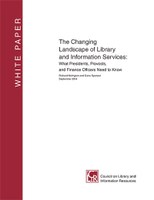
Number 101 • September/October 2014
ISSN 1944-7639 (online version)
Contents
Follow DLF Forum via Twitter and Livestream
Committee on Coherence at Scale: Update
White Paper Explores Emerging Opportunities for Library and Information Technology Services
DLF Contribute Highlights New Members’ Work
CLIR Welcomes New Staff Members
Apply Now For …
We invite you to view our weekly blog series, “Re: Thinking,” which features perspectives from a variety of contributors on topics relating to the emerging digital environment, research, and higher education. In the latest blog, “Building a Community of Practice for Research Data Services,” Research Services Librarian Mayu Ishida posts on her experience in the CLIR/DLF E-Research Peer Networking and Mentoring Group.
CLIR Issues is produced in electronic format only. To receive the newsletter electronically, please sign up at https://www.clir.org/pubs/issues/signup.html. Content is not copyrighted and can be freely distributed.
 Follow DLF Forum via Twitter
Follow DLF Forum via Twitter
and Livestream
Can’t attend the DLF Forum, October 27–29? Many of the sessions will be livestreamed. View the schedule here.
You can also follow the Forum on Twitter, #dlfforum.
The Committee on Coherence at Scale: Update
by Chuck Henry
 It’s true: the Committee on Coherence at Scale wants to enhance higher education thoughtfully, deliberatively, and systematically. Formed in 2012, the Committee is anchored by the observations that many very large-scale (national-level) projects have begun to flourish, and that these projects represent vital facets in the cycle of academic knowledge (e.g., preservation, data curation, new forms of publishing, archiving, institutional repositories, and immensely large, accessible libraries of cultural heritage objects). In the context of these observations, a strongly held hypothesis animates the Committee: if these projects and others like them were brought together and designed as functional parts of an even greater system, a new, robust environment could be constructed for higher education. Such a system, built through a vigorous collaboration of stakeholders, could ameliorate the prevailing competition for academic resources and external funding—a mindset that is costly and inefficient—and support teaching, learning, and research with an unprecedented, cost-effective resource. That is the chief aspiration of the Committee on Coherence: at once technical, cultural, and behavioral.
It’s true: the Committee on Coherence at Scale wants to enhance higher education thoughtfully, deliberatively, and systematically. Formed in 2012, the Committee is anchored by the observations that many very large-scale (national-level) projects have begun to flourish, and that these projects represent vital facets in the cycle of academic knowledge (e.g., preservation, data curation, new forms of publishing, archiving, institutional repositories, and immensely large, accessible libraries of cultural heritage objects). In the context of these observations, a strongly held hypothesis animates the Committee: if these projects and others like them were brought together and designed as functional parts of an even greater system, a new, robust environment could be constructed for higher education. Such a system, built through a vigorous collaboration of stakeholders, could ameliorate the prevailing competition for academic resources and external funding—a mindset that is costly and inefficient—and support teaching, learning, and research with an unprecedented, cost-effective resource. That is the chief aspiration of the Committee on Coherence: at once technical, cultural, and behavioral.
Grant Partnerships
Following the Committee’s first meeting at Vanderbilt in 2013, several members began to write grant proposals on behalf of the Coherence agenda. For CLIR, this round of grant writing inaugurated an important new tactical direction: rather than developing grants solely for the Council, we joined with universities and colleges that promote CLIR’s vision and mission by virtue of our shared interests and goals as articulated by the Committee on Coherence. The partnering institutions are the recipients of the funding. Two grants from The Andrew W. Mellon Foundation, awarded earlier this year, are exemplary of this approach. One, awarded to Vanderbilt University, supports some of the operational costs of the Committee on Coherence, including a research fellowship. The other, awarded to the University of Pittsburgh, funds multiple-year fellowships for doctoral candidates in the I-School consortium whose dissertation research aligns with aspects of the digital architecture the Committee believes is necessary to build out the new virtual environment.
Also in 2014, CLIR through the Committee on Coherence promoted the project SHARE (SHared Academic Research Ecosystem) as an exemplary at-scale, collaborative project. SHARE, a partnership of the Association of Research Libraries, Association of American Universities, and Association of Public and Land-Grant Universities, aims to build a series of institutional repositories that are interoperable and national in scope. SHARE received a generous grant jointly from the Sloan Foundation and the Institute for Museum and Library Services. CLIR also contributed to a proposal for a grant, awarded this summer to Stanford University, focusing on new measures and assessment methods for academic libraries in the 21st century. This grant funds the design of a template for the components of a new methodology to measure in a more sophisticated way library services and programs in public and private universities in the United States.
There are a few more grants pending that could further invigorate and focus the Committee on Coherence. One is to fund new forms of scholarly publishing in the humanities and social sciences. A joint project between the University of Richmond and Stanford University, this grant would help to catalyze and accelerate the publication of new scholarly research that is distinct from the traditional printed monograph. Multimedia, multi-layered publications (which could encompass the scholarly argument, background materials, data, algorithms, reviews, and revisions) are envisioned as likely models for which a technical infrastructure will be designed for wider adoption and perseverance. Another major pending grant is CLIR-specific, but has been written with exceptionally wide consultation: we hope to transition the Cataloging Hidden Special Collections and Archives program to a competition for digitization of rare and special materials of proven importance to scholarship and teaching.
Like all projects sponsored by the Committee on Coherence, these will be executed as complementary: the significant increase in available digital objects will affect the methodology and presentation (publication) of future scholarship. As importantly, the digital library that will be built if the digitization of special and rare collections is funded will need to be accessible through projects such as the Digital Public Library of America and preserved as resources in, for example, a national system of dark archiving such as the Digital Preservation Network.
Funds will be sought next year for two nascent programmatic efforts involving current and past CLIR/DLF postdoctoral fellows. Both programs will engage fellows in research, consulting, and publishing on behalf of projects across the country that reside at institutions that do not have the depth of experience or infrastructure to fully execute them. As currently conceived, these Coherence-supported grants will seek to demonstrate the value of a culture of collaboration, providing training and expert help with the use of new technologies, often using the institution’s library to bring together cross-disciplinary scholars and support their interactions.
The first project, led by George Washington University, CLIR/DLF, and ARL, will focus on digital humanities. The second, led by ARL, CLIR/DLF, and several other colleges and universities, will focus on STEM teaching and learning programs. Each builds upon existing expertise and realigns that experience and knowledge as a national network: a system comprised of an exceptionally talented pool. They will take advantage of the extant centers of activity without further investment in any physical plant.
Three-Phased Project
With the projects that are currently funded and under way, and with the hoped-for funding for several projects now in the planning stage, the first phase of the Committee on Coherence at Scale will conclude in the spring of 2015. For the following three years—phase two—these grant-supported projects and programs, in tandem with many other sources of study and exploration, will investigate, assess, and publish an enormous amount of information pertinent to understanding the technology, costs, long-term benefits, impact on education and our cultural heritage, and potential opportunities for knowledge discovery that a new digital environment would afford. Phase three, if the research supports it, will entail the construction and sustaining of a new ecosystem that is coherent at scale.
In his engaging and lucid new book, The Innovators: How a Group of Hackers, Geniuses, and Geeks Created the Digital Revolution, Walter Isaacson brings to life the complex social, cultural, and personal relationships that in aggregate created our current digital environment. Two themes thread throughout the narrative, one obvious, one not. First, big ideas need to be adopted at a very large scale to work; second, collaboration—not isolated, individual dreaming and tinkering—gave rise to our digital era. The Committee on Coherence at Scale embodies these themes, and essentially combines them: to build out a new digital ecology for education in the United States, national-scale collaboration is requisite. This collaboration is both institutional and conceptual in nature. Schools, projects, programs, and the technical infrastructure on which they function need to be continually contextualized as part of a new system that, when built, will represent an accessible and sustainable—perhaps astonishing—public good.
Watch a brief video on the Committee on Coherence at Scale for Higher Education
White Paper Explores Emerging Opportunities for Library and Information Technology Services
 Rapidly evolving digital technologies and services, coupled with a changing economy, are profoundly influencing the financial model supporting many colleges and universities. Balancing budgets has become more difficult, and new challenges to the traditional business model are emerging. Colleges and universities must seize new opportunities to thrive.
Rapidly evolving digital technologies and services, coupled with a changing economy, are profoundly influencing the financial model supporting many colleges and universities. Balancing budgets has become more difficult, and new challenges to the traditional business model are emerging. Colleges and universities must seize new opportunities to thrive.
A new white paper from CLIR, The Changing Landscape of Library and Information Services: What Presidents, Provosts, and Finance Officers Need to Know, examines the challenges and opportunities from the perspective of library and information technology services (LITS). The report is based on a December 2013 workshop organized by the CLIR Chief Information Officers (CIOs) group, comprising individuals from institutions that have merged their library and information services organizations.
Four questions prompted the workshop discussion:
- What are the essential qualities of our information services organizations when they are at their best?
- What changes are we likely to experience in our organizations and the environment in the next 10 years?
- What framework is a successful information services organization at a small college likely to have in 2024?
- What strategies should we employ to prepare ourselves for this future?
CIOs Richard Holmgren, of Allegheny College, and Gene Spencer, of Ursinus College, draw on these discussions to identify opportunities for LITS organizations to improve student outcomes, increase revenue, and manage costs.
The Promise of Information Technology
One set of opportunities is afforded by new information technologies and analytic capabilities, which can help institutions better understand student needs and target services. The authors note that “increased collection and analysis of data captured from student interactions with campus systems can help predict who is at risk of leaving the institution, who would benefit from more or different interventions to support their learning, and what strategies are most effective to respond to the needs of which students.”
Information technology’s potential to improve campus outcomes goes beyond administrative functions. Holmgren and Spencer cite the Texas Language Consortium, sponsored by five small Texas colleges, and the Sunoikisis project, developed by the Associated Colleges of the South, as examples of how technology can facilitate shared programs while reducing costs. The authors also note the potential for blended learning to deliver learning outcomes that are at least as good as traditional approaches, but are more cost-effective.
The Promise of Library as Place
As virtual collections replace their physical analogs, freeing up library space, there is an opportunity to rethink the role of the building as an academic hub. Many colleges and universities are already transforming their library buildings into academic commons that incorporate new services such as writing centers, student advising offices, and media creation centers. “Rebranding the library as an academic commons and demonstrating its role as a collaborative interaction and study space provide an argument for the value of the residential college experience, and the creation of a visible center for academic support demonstrates to prospective students and their families the college’s commitment to supporting student success,” note Holmgren and Spencer.
The authors caution that many groups—students, faculty, alumni, library staff, and the administration—have an important stake in the library, and that adequate consultation with stakeholders is essential. “Reclaiming and harnessing library space to address larger institutional issues require extended, thoughtful, and responsive dialog with all constituent groups, and the entire campus leadership team must engage in the process if it is to be negotiated successfully.”
Core Competencies
The ability to engage stakeholders is, and will continue to be, among the most important attributes for staff of LITS organizations. For the institutions represented at the workshop, the individual charged with leading change in library and technology services is the CIO. As the group considered the core competencies that their organizations would need to support positive institutional change in the next decade, they identified three key areas:
Communication and facilitation: Technology implementations are complex projects that become even more challenging when meaningful change to business processes accompanies the implementation. LITS staff must become adept at listening to all constituents, synthesizing the information, and communicating new ideas and processes in ways that make sense to those affected by them.
External relationship management: As more information services move to the web on systems hosted by external providers, LITS staff will increasingly need to negotiate and manage complex contracts and vendor relationships. Staff will have to develop healthy relationships with service providers while maintaining enough distance to preserve their independence. They will also need the skills and knowledge to choose from among many service options and negotiate a contract that meets the college’s needs.
Data management and systems integration: As educational institutions move more of their data and processes to electronic systems, which are frequently hosted by off-campus providers, managing the data in those systems becomes more challenging. LITS staff will have to further develop their abilities in a variety of areas relating to data management. But the responsibility for data management cannot reside with LITS organizations alone; staff will also need the skills to engage their colleagues outside LITS organizations as effective stewards and consumers of institutional data.
Beyond these competencies, the CIOs believe that “they must foster an organizational ethos that values and nurtures flexibility, nimbleness, a broad understanding of the college’s mission, and a passionate commitment to the college’s continued success. Colleges that shift the role of their LITS organizations to embrace these new demands will be well situated for continued success.”
CLIR sponsors are invited to join us for a webinar featuring authors Richard Holmgren and Gene Spencer, and Linda DeMeritt, provost and dean of the college at Allegheny College, on Tuesday, October 21, at 1 pm. Register here.
DLF Contribute Highlights New Members’ Work
The Digital Library Federation has welcomed 28 new members this year. Over the next 12 months, DLF Contribute will feature biweekly posts from these new members on their digital library projects. In the most recent post, Baylor University Libraries highlights the Black Gospel Music Restoration Project and The Browning Letters project. We invite you to have a look!
CLIR Welcomes New Staff Members
-

N. Ferraiolo (L) and E. Gallivan (R)
CLIR welcomes new staff members Nicole Ferraiolo and Emily Gallivan.
Program Officer for Scholarly Resources Nicole Ferraiolo works primarily with the Hidden Collections program and Mellon Fellowships for Dissertation Research in Original Sources. She was previously a researcher at Columbia University’s Brown Institute for Media Innovation and a program coordinator in Columbia’s Department of History.
DLF Program Assistant Emily Gallivan provides support for a range of DLF program activities, and will be on hand for the upcoming DLF Forum. She comes to CLIR with experience in marketing and graphic design, most recently from the School Justice Project and Quatrefoil Associates, Inc., where she served as creative coordinator.
Apply Now For . . .
Leading Change Institute 2015
The Leading Change Institute (LCI), successor to the Frye Leadership Institute, invites applications from leaders in libraries and information technology who seek to further develop their skills for the benefit of higher education. The 2015 Institute will be held in Washington, DC, May 31-June 5. Program information is available here. Applications must be received by 5 pm Eastern time on Monday, December 1, 2014. For more information on how to apply, and for a link to the online application form, click here. LCI is cosponsored by CLIR and EDUCAUSE.
Mellon Fellowships for Dissertation Research in Original Sources
Fellowships support dissertation research in the humanities or related social sciences in original sources. About 15 fellowships are awarded annually, each providing a stipend of $2,000 per month for periods ranging from 9-12 months. Applications must be received by 5 pm Eastern time on Monday, November 17, 2014. For more information on the fellowships and a link to the online application form, click here. Fellowships are supported with funding from The Andrew W. Mellon Foundation.

